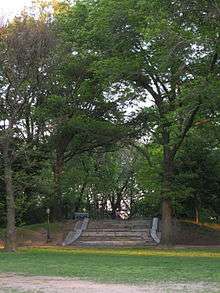Mount Prospect Park
Coordinates: 40°40′18″N 73°58′00″W / 40.671552°N 73.966535°W

.jpg)
Mount Prospect Park is a 7.79-acre (3.15 ha) park in the central portion of the New York City borough of Brooklyn. It includes Mount Prospect, the second highest point in Brooklyn. It is located on Eastern Parkway near Underhill Avenue, close to Grand Army Plaza. The park is operated by the New York City Department of Parks and Recreation.[1]
It is not the same as the much larger and better-known Prospect Park, which is across Flatbush Avenue from Mount Prospect Park.
Mount Prospect Park shares a common parcel of land with other Brooklyn cultural institutions—the Brooklyn Museum, Brooklyn Botanic Garden and the Central Library of the Brooklyn Public Library.
History
Mount Prospect is named for its sweeping views (some no longer possible) of Manhattan, Brooklyn, and parts of New Jersey and Staten Island to the west, the Atlantic Ocean to the south, and Long Island to the east.[1] Peak elevation is 200 feet (61 m) above sea level.[2] It was a lookout point for Continental Army troops defending the Heights of Guan in 1776. The Battle of Long Island (sometimes called Battle of Brooklyn) was fought nearby.[1]
In 1856, the then City of Brooklyn built a reservoir atop Mt. Prospect,[1] soon to be supplemented by the larger Ridgewood Reservoir. In 1860, Mt. Prospect was to be included in the city's ambitious new Prospect Park, to be designed by Calvert Vaux and Frederick Law Olmsted, who were in the process of designing the more famous Central Park for New York City. The designers felt that the fact that Flatbush Avenue, the main roadway from Brooklyn to Flatbush, would cut through the park meant that the eastern portion of potential parkland including Mt. Prospect should not be included.[1]
Brooklyn City kept control of the land, which then passed to the City of Greater New York in 1898. Various plans were made for the rejected parkland, including its division into city streets and lots. The major portion of the land became Institute Park, a private park, which was developed into today's Brooklyn Botanic Garden, still a private institution.
The City retained the reservoir at Mount Prospect until it was deemed obsolete due to the shifting of the New York City water supply system to sources in Upstate New York. In 1940, Mount Prospect Park was moved to the Parks Department as a city park and playground.[1]
References
- 1 2 3 4 5 6 Mount Prospect Park, New York City Department of Parks and Recreation, accessed July 3, 2008.
- ↑ Source: USGS topographic maps